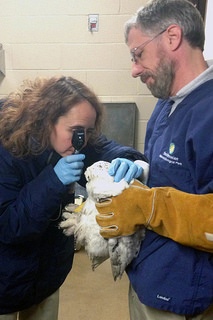I had been reading a lot this winter about the irruption of snowy owls, then, about a month ago, I saw a snowy owl myself right here in downtown Washington, D.C., perched above a parking sign with its beak tucked under its wing.

Snowy owls usually stay near the Arctic Circle for breeding, often coming south toward the Canada-U.S. border during winter. This winter, however, many have been spotted in the Midwest and on the East Coast much farther south than is usual. The phenomenon has birders and other wildlife enthusiasts excited about the rare chance to see one of these beautiful creatures. I stood in the cold for some time with a few other admirers, watching the owl that had graced our city streets from a respectful distance.

It’s not yet clear what brings so many snowy owls so far outside their range this year. Theories range from a dearth of their favorite food forcing them to travel farther in search of meals, to an abundance of food last year having allowed for a very successful breeding season, meaning more owls that would need to spread out farther. Food shortages occur and drive owls farther afield every six to 10 years, but this year’s abundance of southbound “snowies” is particularly remarkable. “An irruption like this probably hasn’t happened in 30 years or more,” ornithologist Peter Paton with the University of Rhode Island tells the Providence Journal, adding that some have been spotted as far as Florida and Bermuda.

Another ornithologist, Dr. Kevin J. McGowan of Cornell University, doesn’t want to rule out the effects of climate change yet, either. He tells the New York Times that the disruption to the snowy owls’ arctic habitat — which he calls “one of the most vulnerable ecosystems on the planet” may also be driving them farther south.
Either way, the owls’ big adventure down south can be dangerous for them. Their usual habitat is one sparsely populated by humans and they’re now venturing into densely populated areas with obstacles they aren’t used to. Like traffic. Several owls have been reported killed by traffic and airplanes in East Coast cities. Last week, a snowy owl in downtown D.C. — most likely the very owl I had stopped to watch a month ago in the same area — was hit by a bus and injured. Happily, that owl has been taken to the National Zoo for veterinary care.
So, if you’re in one of the areas these owls are now venturing into, enjoy the chance to see these beautiful birds in person. Just remember to observe from a respectful distance.